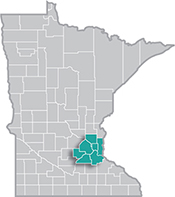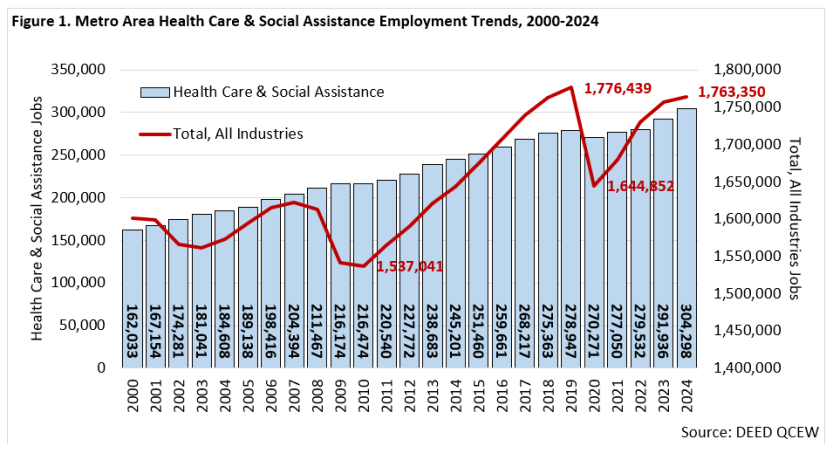 The Minneapolis-St. Paul metropolitan area is a national leader in finance, advanced manufacturing, agriculture and retailing.
The Minneapolis-St. Paul metropolitan area is a national leader in finance, advanced manufacturing, agriculture and retailing.
Medical devices, electronics and processed foods are strong suits recognized globally.
Want the freshest data delivered by email? Subscribe to our regional newsletters.
Health Care & Social Assistance is the Metro Area's largest-employing industry sector.
5/20/2025 11:49:31 AM
Tim O'Neill
Health Care & Social Assistance is the Metro Area's largest-employing industry sector. According to DEED's Quarterly Census of Employment & Wages (QCEW), this industry had 14,721 establishments in 2024 supplying nearly 304,300 covered jobs. As such, over one-in-six jobs in the Metro Area are in Health Care & Social Assistance. The next largest-employing industry, Manufacturing, has 131,500 less jobs.
Additionally, Health Care & Social Assistance has been the Metro Area's largest-growing industry. Between 2010 and 2024, Health Care & Social Assistance gained over 87,800 net new jobs. This equated to a growth rate of 40.6%, which was about three times faster than the growth across the total of all industries during that period. More recently, between 2019 and 2024, Health Care & Social Assistance gained over 25,300 jobs. Of the eight major industry sectors to gain jobs during this period, Health Care & Social Assistance was at the top. In fact, it accounted for more employment growth than the remaining seven industries combined. During this period, all industries were down about 13,100 jobs, still looking to recover the jobs lost due to the COVID pandemic in 2020 (Figure 1).

With the recent and historic growth in healthcare employment in the Metro Area, it follows that this industry has the most job vacancies of any industry. In 2024, DEED's Job Vacancy Survey (JVS) reveals that there were just over 17,300 job vacancies in Health Care & Social Assistance in the Twin Cities. This accounted for fully one-quarter (26.1%) of the region's total job vacancies, which was just over 66,400 in 2024.
Along with industry sectors, DEED's JVS allows users to explore job vacancies by occupational groups and specific occupations. Health Care & Social Assistance has a wide variety of occupations, including managerial occupations and office and administrative support, food preparation and serving occupations, information technology and more. If we zoom in on those occupations more specific to healthcare, we get Healthcare Practitioners & Technical Occupations as well as Healthcare Support Occupations.
In 2024, the Metro Area had 12,600 job vacancies between Healthcare Practitioners & Technical Occupations and Healthcare Support Occupations (Table 1). Occupations in the Healthcare Practitioners & Technical Occupations group typically require postsecondary education, require prior work experience and generally have higher median wage offers. Meanwhile, occupations in the Healthcare Support Occupations group do not typically require postsecondary education, do not require as much work experience and are more likely to be part-time. Median wage offers are, typically, going to be lower in this occupational group.
| Table 1. Healthcare Occupational Vacancies in the Metro Area, 2024 | |||||
|---|---|---|---|---|---|
| Occupational Group | Number of Vacancies | Median Wage Offer | Share Part-Time | Requires Postsecondary Education | Requires Work Experience |
| Total, All Occupations | 66,411 | $22.30 | 27% | 41% | 52% |
| Healthcare Practitioners & Technical Occupations | 7,696 | $35.69 | 30% | 90% | 63% |
| Healthcare Support Occupations | 4,904 | $18.91 | 37% | 22% | 20% |
| Source: DEED Job Vacancy Survey | |||||
Between these two occupational groups, there are countless ways to enter the healthcare field and advance along career pathways. See the listing below for those healthcare occupations with the most job vacancies in the Metro Area. Metro Area Healthcare occupations with the most current job vacancies:
Contact Tim O'Neill, Labor Market Analyst, at timothy.oneill@state.mn.us
If you’d like to find out more about Health Care & Social Assistance career opportunities in Minnesota or if you are an employer looking to hire workers, contact staff at a CareerForce location near you.